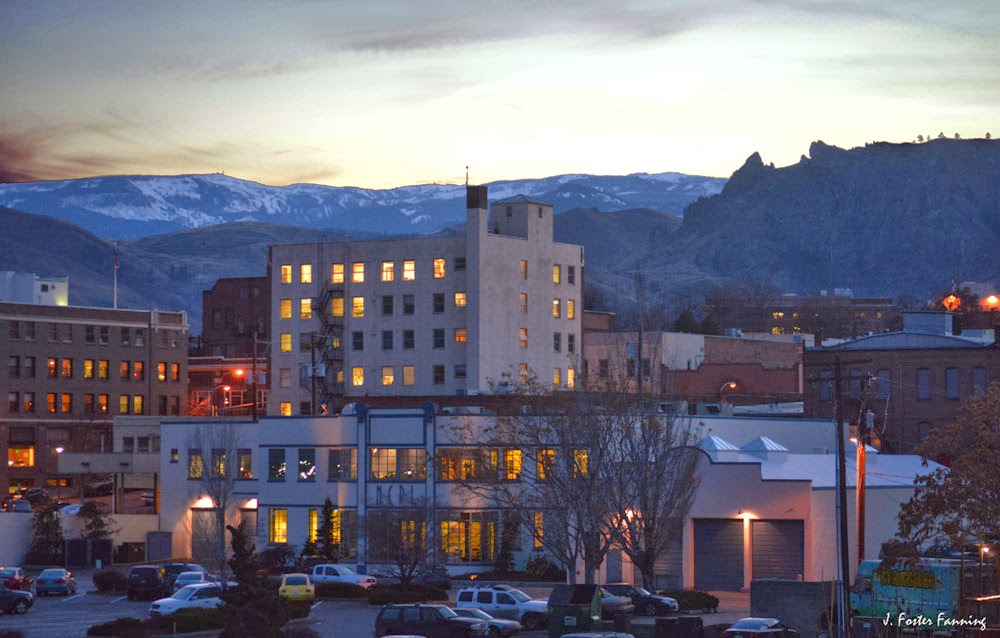Wenatchee Washington, named after the Wenatchi Indian tribe
in the native language of Sahaptin means "river
which comes from canyons". And appropriately so as Wenatchee is
located along not only the banks of the mighty Columbia river for the entire
city length, but a northwest portion of “The Apple Capital Of The World” is at
the mouth of the Wenatchee River Canyon.
 |
| Downtown Wenatchee looking from the Columbia River across town to the Mission Ridge Ski Area located above this Eastern Washington City. |
Population for this Eastern Washington
City was at 32,520 at the 2013 census. The 'Wenatchee Valley Area' refers to
the land between two of the Columbia River dams – the Rocky Reach (upstream) and
the Rock Island (downstream) including East Wenatchee, Rock Island, and Malaga.
These local environs sprawl across portions of Chelan and Douglas counties
(divided by the Columbia River).
 |
| Looking upstream across the Columbia River to a portion of Wenatchee from the Kirby Billingsley Hydro Park |
Not only does Wenatchee have the moniker of "Apple
Capital of the World" (due to the valley's many orchards) but the city is
also referred to as the "Power Belt of the Great Northwest". This is
a metaphor for the series of hydroelectric dams on the Columbia River. Rock
Island Dam is located nearest to the middle of this "belt", and so
was labeled the "Buckle". This saying is printed at the top of every
issue of Wenatchee's newspaper, the Wenatchee World.
 |
| Great blue heron off Walla Walla Point on Wenatchee waterfront with Pipeline/Pedestrian Bridge in background. |
The historic Pipeline/Pedestrian Bridge, opened in 1908 as the first road bridge over the Columbia River south of Canada. It also accommodated pipelines for irrigation of orchards east of the River. It is a steel truss bridge over one thousand feet in length connecting the cities of Wenatchee and East Wenatchee. And now serves as a pedestrian / bike path bridge while still carrying irrigation water across the Columbia River.
During our January, 2014 visit to Wenatchee we lucked out with hitting the weather window - four days reaching fifty degrees Fahrenheit with one of those tagging 55*. Believe me, coming from the Canadian border area a few days in the warm sunshine in the middle of winter was welcome.
During our January, 2014 visit to Wenatchee we lucked out with hitting the weather window - four days reaching fifty degrees Fahrenheit with one of those tagging 55*. Believe me, coming from the Canadian border area a few days in the warm sunshine in the middle of winter was welcome.
 |
| January full moon rise over East Wenatchee |
The view from Wenatchee to East Wenatchee across the Columbia River with January's full moon rising.
The Confluence of Rivers
Geographically the confluence of rivers is the meeting of
two or more large streams of water. This designation refers either to the point
where a tributary joins a larger river, called the main stem, or where two streams
meet to become the source of a river of a new name.
The forty mile long, east flowing Wenatchee River, with it’s
headwaters on the east slope of the Cascade Range, is a variable waterway
tumbling thru cleft wall canyons, winding through basined wetlands, in a
combination of rapids giving way to backwaters. While this image is primarily
of the Columbia River the location is at the confluence with the Wenatchee.
 |
| Confluence of the Wenatchee and Columbia Rivers - mouth of the Wenatchee is on left of image. |
Wenatchee's Waterfront Sculpture Park
Photography displays lead me to research the various images I create, thus continually expanding my knowledge of the region, environment, culture, and topography that I live in and visit. Often I enjoy the research as much as the photography itself, well almost…
Photography displays lead me to research the various images I create, thus continually expanding my knowledge of the region, environment, culture, and topography that I live in and visit. Often I enjoy the research as much as the photography itself, well almost…
This impressive sculpture entitled WELCOME can be found in
Wenatchee in the Sculpture Garden along their waterfront park. It stands
approximately 10 feet tall, created in bronze, stainless steel, and copper by
artist Jim Johnson of Salem Oregon. The plaque with the sculpting states that
it is part of “Arts on the Avenue – Visiting Sculpture” and is for sale for
$10,000. I caught this image with the January full moon rising behind the
sculpting and incorporated the moon into the artwork itself.
Another image from a recent trip to Wenatchee, back in the warmer weather of January (50* on the 5th). This is a sculpture entitled WINGS. Here is the dedication on the base: WINGS by Gary Lee Price – dedicated by Art on the Avenues in 2012 to honor the Wenatchee School District recipient of Art on the Avenues 2012 Adele Wolford Founder’s Award for over support of the arts.
To Be Continued...
XXX







